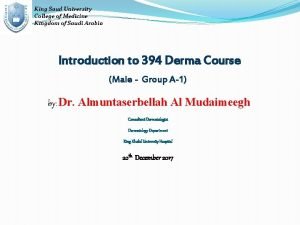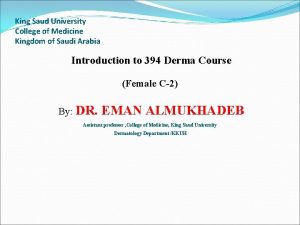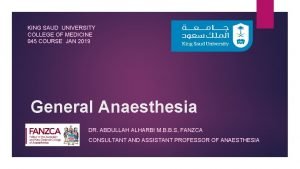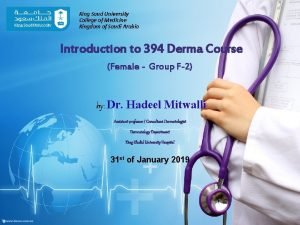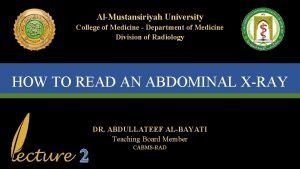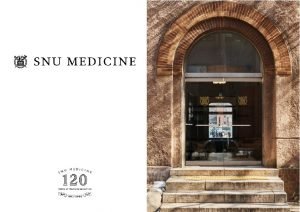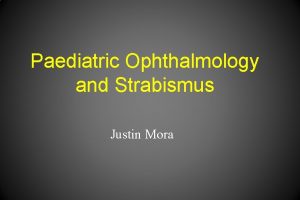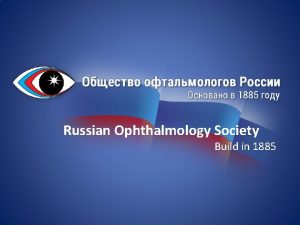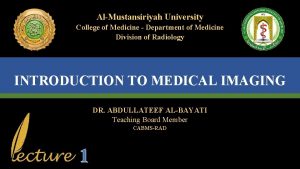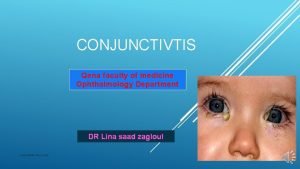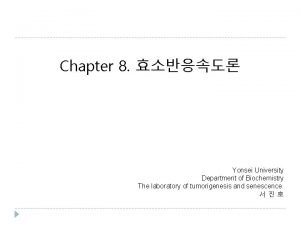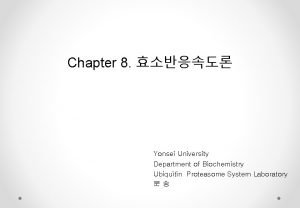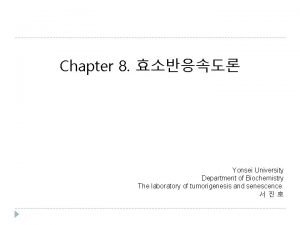Department of ophthalmology Yonsei University college of medicine












- Slides: 12

Department of ophthalmology, Yonsei University, college of medicine Tae-im Kim, Sang Woo Kim, Byung Jin Ha, Eung Kweon Kim

Introduction Vistech VCTS (Vision Contrast Test System) ® 6500 - under normal room lighting (30 -60 ft L) - recommanded distance : Far - 10 feet (3 m) - measure with best optical correction contrast changes: Average in 0. 25 log unit step 5 different spatial frequencies (1. 5, 3, 6, 12, 18 cpd) each stimulus has ± 15° tilted sine wave criterion dependent method : right, left, up and blank

Introduction Optec ® 6500 Stero Optical co. , Inc. Chicago, IL, USA Microprocessor-controlled and continually calibrated light levels ; Target illumination with 3. 0 cd/m² for night or 85 cd/m² for day ; Compliance with the ANSI Contrast sensitivity slide package ; F. A. C. T® sine wave or C. A. T letter Near and Far testing capability Binocular glare testing Eyeview® software Data base for research

Introduction F. A. C. T (Functional Acuity Contrast Test) ® 201 - consists of the circular stimuli in 5 rows and 8 columns - recommended distance : Far - 10 feet (3 m) - measure with best optical correction contrast changes: Average in 0. 15 log unit step 5 different spatial frequencies (1. 5, 3, 6, 12, 18 cpd) Larger patch size than VCTS : 1. 7 degrees each stimulus has ± 15° tilted sine wave 3 Alternative forced choice : right, left, up

Purpose To investigate the repeatability and sensitivity of Optec® 6500 for contrast sensitivity measurement, comparing with commonly used Vistec VCTS 6500 chart in normal, healthy subjects

Methods Subjects Ø 40 eyes of young healthy volunteers, (14 male and 6 female) (total) Ø age 27. 5 (26 ~ 34 years old) Ø BCVA of all subjects; 0. 8 or better Ø Excluding criteria - any ocular pathology (cataract, glaucoma, retinal disease etc) - any previous ocular surgery - any neurological problem - any systemic disease - insufficient mental ability to perform the test - physical disability which make it difficult to perform the test

Methods Procedure measurements done twice with 1 week interval with optimal refractive correction and natural pupil 1. Measurements of CST with Vistech VCTS 6500 ( Group 1 ) under room luminance (≒ 120 cd/m 2), working distance of 3 m 2. Measurements of CST with Optec 6500 ( Group 2 ) under continually controlled luminance : 85 cd/m 2 using F. A. C. T 201 chart Data and Statistics 1. Numericalized CST values, using conversion chart 2. Contrast sensitivity were compared at all frequencies Sensitivity : T test, Repeatability : Bland Altman plot Coefficient of Repeatibility (COR) 3. STSS v 10. 1 for windows (SPSS Inc. , Chicago, IL, USA)

Results Contrast sensitivity CST of VCTS and Optec 6500 (mean, 95% CI) u n VCTS Optec Range of VCTS Range of Optec Spatial Frequency (cpd) * T test, p<0. 001, n=80 for each frequency

Results Table. Mean and Standard deviation of CST between test and retest Vistech Optec ® 6500 Test (Mean (SD)) Retest (Mean (SD)) 1. 5 cpd 74. 13 (19. 96) 75. 00 (24. 49) 3. 0 cpd 126. 86 (48. 28) 140. 85 (47. 58) 6. 0 cpd 162. 13 (49. 82) 173. 25 (43. 54) 12 cpd 135. 53 (33. 48) 129. 98 (28. 39) 18 cpd 62. 50 (15. 61) 60. 90 (18. 69) 1. 5 cpd 45. 3 (20. 86) 47. 6 (21. 15) 3. 0 cpd 90. 73 (48. 01) 87. 60 (29. 09) 6. 0 cpd 100. 70 (47. 56) 92. 78 (41. 97) 12 cpd 49. 23 (21. 17) 47. 73 (22. 90) 18 cpd 19. 28 (12. 51) 15. 60 (9. 41) * n=40

Results Ø Maximal contrast sensitivity was observed at 6 cpd and was significant higher if compared to 1. 5, 12 and 18 cpd in both test using two different machine. Ø The distributions of the score of contrast sensitivity test are similar in both test. Ø The scores of contrast sensitivity of Optec 6500 are relatively low. Ø The discrepancy of repeated test is also less prominent in Optec 6500.

Discussion Ø Contrast sensitivity (CS) describes the ability to distinguish differences in luminance Ø There are several commercially available clinical testers : The Vistech CS chart series are popular but, reported not to warrant repeatability in several papers Ø Optec® 6500 Vision Tester : based on the Functional Acuity Contrast Test (FACT) multifunctional instrument measurement of visual acuity, contrast sensitivity, disability glare as well as stereo- and color vision.

Conclusions 1. Sensitivity of contrast sensitivity test with Vistec VCTS is better than that Optec 6500 in normal eye. 2. Testing results using Optec 6500 improved accuracy in analysis of contrast sensitivity with narrow range score, accurate CST, and adopting strict 3 alternative forced choice method for analysis 3. Repeatability of each test using Optec 6500 is better than that of Vistec VCST 4. Measurement of contrast sensitivity with Optec 6500 might be comparable or better in studies to compare the quality of implanted lenses or refractive surgery outcome than Vistec VCTS
 Yonsei university college of nursing
Yonsei university college of nursing Computer science yonsei university
Computer science yonsei university Lincoln memorial university college of veterinary medicine
Lincoln memorial university college of veterinary medicine King saud university college of medicine
King saud university college of medicine King saud university college of medicine
King saud university college of medicine King saud university college of medicine
King saud university college of medicine King saud university college of medicine
King saud university college of medicine Enteroclysis vs barium follow-through
Enteroclysis vs barium follow-through Midwestern university college of dental medicine
Midwestern university college of dental medicine Seoul university medical school
Seoul university medical school Ukcom curriculum
Ukcom curriculum Kozeny carman equation
Kozeny carman equation 詹景裕
詹景裕



